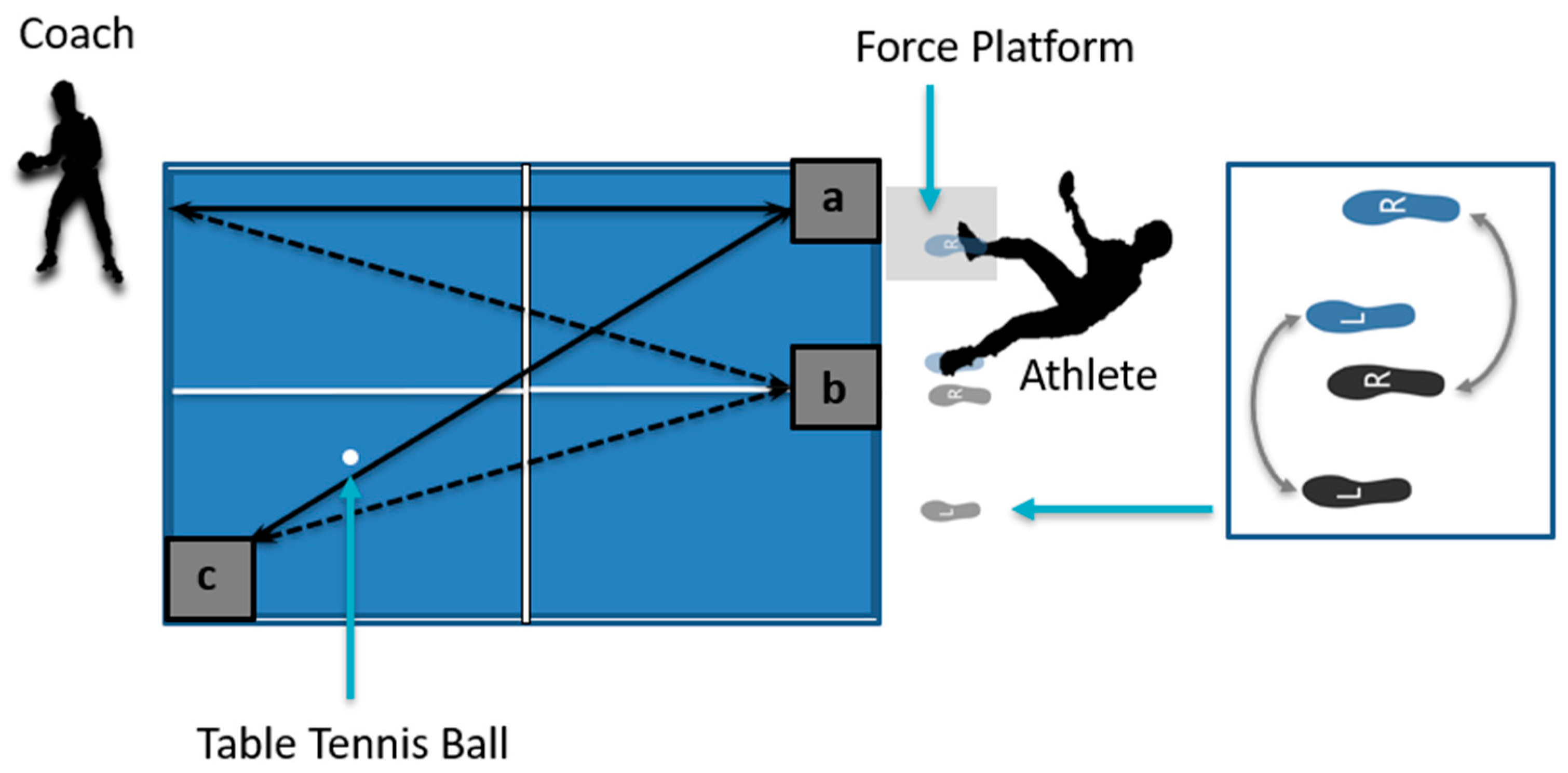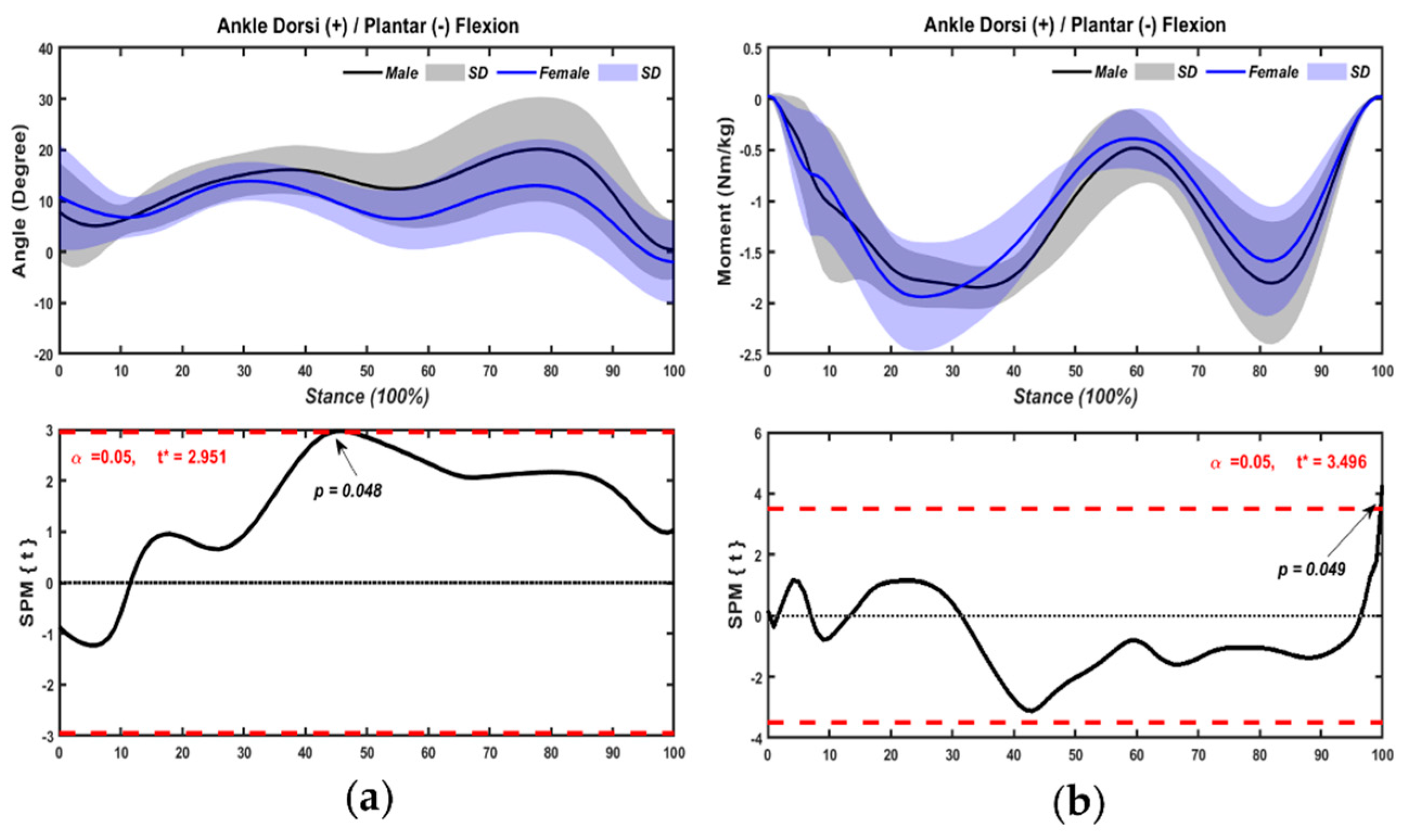Understanding Sex-Based Kinematic and Kinetic Differences of Chasse-Step in Elite Table Tennis Athletes
Abstract
1. Introduction
2. Materials and Methods
2.1. Participants
2.2. Experimental Procedures
2.3. Data Processing
2.4. Statistical Analysis
3. Results
3.1. Kinematics and Kinetics
3.1.1. Hip Joint
3.1.2. Knee Joint
3.1.3. Ankle Joint
3.2. Stiffness of Lower Extremity
4. Discussion
5. Conclusions
Author Contributions
Funding
Institutional Review Board Statement
Informed Consent Statement
Data Availability Statement
Acknowledgments
Conflicts of Interest
References
- Malagoli Lanzoni, I.; Di Michele, R.; Merni, F. A Notational Analysis of Shot Characteristics in Top-Level Table Tennis Players. Eur. J. Sport Sci. 2014, 14, 309–317. [Google Scholar] [CrossRef] [PubMed]
- Bańkosz, Z.; Winiarski, S. Kinematic Parameters of Topspin Forehand in Table Tennis and Their Inter-and Intra-Individual Variability. J. Sport. Sci. Med. 2020, 19, 138–148. [Google Scholar]
- Giandonato, J.A.; Tringali, V.M.; Thoms, R.C. Improving Mental Health through Physical Activity: A Narrative Literature Review. Phys. Act. Health 2021, 5, 146–153. [Google Scholar] [CrossRef]
- Bańkosz, Z.; Winiarski, S. Correlations between Angular Velocities in Selected Joints and Velocity of Table Tennis Racket during Topspin Forehand and Backhand. J. Sport. Sci. Med. 2018, 17, 330–338. [Google Scholar]
- Wong, D.W.C.; Lee, W.C.C.; Lam, W.K. Biomechanics of Table Tennis: A Systematic Scoping Review of Playing Levels and Maneuvers. Appl. Sci. 2020, 10, 5203. [Google Scholar] [CrossRef]
- Malagoli Lanzoni, I. Footwork Technique Used in Elite Table Tennis Matches. Int. J. Racket Sport. Sci. 2020, 1, 44–48. [Google Scholar] [CrossRef]
- Lam, W.K.; Fan, J.X.; Zheng, Y.; Lee, W.C.C. Joint and Plantar Loading in Table Tennis Topspin Forehand with Different Footwork. Eur. J. Sport Sci. 2019, 19, 471–479. [Google Scholar] [CrossRef]
- Yu, C.; Shao, S.; Awrejcewicz, J.; Baker, J.S.; Gu, Y. Lower Limb Maneuver Investigation of Chasse Steps among Male Elite Table Tennis Players. Medicina 2019, 55, 97. [Google Scholar] [CrossRef]
- Kasper, K. Sports Training Principles. Curr. Sports Med. Rep. 2019, 18, 95–96. [Google Scholar] [CrossRef]
- Boyer, K.A.; Freedman Silvernail, J.; Hamill, J. Age and Sex Influences on Running Mechanics and Coordination Variability. J. Sports Sci. 2017, 35, 2225–2231. [Google Scholar] [CrossRef]
- McLean, S.G.; Walker, K.B.; Van Den Bogert, A.J. Effect of Gender on Lower Extremity Kinematics during Rapid Direction Changes: An Integrated Analysis of Three Sports Movements. J. Sci. Med. Sport 2005, 8, 411–422. [Google Scholar] [CrossRef]
- Ng, L.; Campbell, A.; Burnett, A.; O’Sullivan, P. Gender Differences in Trunk and Pelvic Kinematics during Prolonged Ergometer Rowing in Adolescents. J. Appl. Biomech. 2013, 29, 180–187. [Google Scholar] [CrossRef] [PubMed][Green Version]
- Zagatto, A.M.; Milioni, F.; Freitas, I.F.; Arcangelo, S.A.; Padulo, J. Body Composition of Table Tennis Players: Comparison between Performance Level and Gender. Sport Sci. Health 2016, 12, 49–54. [Google Scholar] [CrossRef]
- Delp, S.L.; Loan, J.P.; Hoy, M.G.; Zajac, F.E.; Topp, E.L.; Rosen, J.M. An Interactive Graphics-Based Model of the Lower Extremity to Study Orthopaedic Surgical Procedures. IEEE Trans. Biomed. Eng. 1990, 37, 757–767. [Google Scholar] [CrossRef]
- Gu, Y.; Yu, C.; Shao, S.; Baker, J.S. Effects of Table Tennis Multi-Ball Training on Dynamic Posture Control. PeerJ 2019, 6, e6262. [Google Scholar] [CrossRef]
- Yang, X.; He, Y.; Shao, S.; Baker, J.S.; István, B.; Gu, Y. Gender Differences in Kinematic Analysis of the Lower Limbs during the Chasse Step in Table Tennis Athletes. Healthcare 2021, 9, 703. [Google Scholar] [CrossRef]
- Kondrič, M.; Zagatto, A.M.; Sekulić, D. The Physiological Demands of Table Tennis: A Review. J. Sport. Sci. Med. 2013, 12, 362–370. [Google Scholar]
- Granata, K.P.; Wilson, S.E.; Padua, D.A. Gender Differences in Active Musculoskeletal Stiffness. Part I. Quantification in Controlled Measurements of Knee Joint Dynamics. J. Electromyogr. Kinesiol. 2002, 12, 119–126. [Google Scholar] [CrossRef]
- Chleboun, G.S.; Howell, J.N.; Conatser, R.R.; Giesey, J.J. The Relationship between Elbow Flexor Volume and Angular Stiffness at the Elbow. Clin. Biomech. 1997, 12, 383–392. [Google Scholar] [CrossRef]
- Lim, K.T.; Choi, W.J. Soft Tissue Stiffness over the Hip Increases with Age and Its Implication in Hip Fracture Risk in Older Adults. J. Biomech. 2019, 93, 28–33. [Google Scholar] [CrossRef]
- Miyamoto, N.; Hirata, K.; Inoue, K.; Hashimoto, T. Muscle Stiffness of the Vastus Lateralis in Sprinters and Long-Distance Runners. Med. Sci. Sport. Exerc. 2019, 51, 2080–2087. [Google Scholar] [CrossRef] [PubMed]
- Bańkosz, Z.; Winiarski, S.; Lanzoni, I.M. Gender Differences in Kinematic Parameters of Topspin Forehand and Backhand in Table Tennis. Int. J. Environ. Res. Public Health 2020, 17, 5742. [Google Scholar] [CrossRef] [PubMed]
- Lephart, S.M.; Ferris, C.M.; Riemann, B.L.; Myers, J.B.; Fu, F.H. Gender Differences in Strength and Lower Extremity Kinematics during Landing. Clin. Orthop. Relat. Res. 2002, 401, 162–169. [Google Scholar] [CrossRef] [PubMed]
- Serrien, B.; Clijsen, R.; Blondeel, J.; Goossens, M.; Baeyens, J.-P. Differences in Ball Speed and Three-Dimensional Kinematics between Male and Female Handball Players during a Standing Throw with Run-Up. BMC Sports Sci. Med. Rehabil. 2015, 7, 1–12. [Google Scholar] [CrossRef]
- Nadler, S.F.; Malanga, G.A.; DePrince, M.; Stitik, T.P.; Feinberg, J.H. The Relationship between Lower Extremity Injury, Low Back Pain, and Hip Muscle Strength in Male and Female Collegiate Athletes. Clin. J. Sport Med. 2000, 10, 89–97. [Google Scholar] [CrossRef]
- Elliott, B.J.; Hookway, N.; Tate, B.M.; Hines, M.G. Does Passive Hip Stiffness or Range of Motion Correlate with Spinal Curvature and Posture during Quiet Standing? Gait Posture 2021, 85, 273–279. [Google Scholar] [CrossRef]
- Knapik, J.J.; Bauman, C.L.; Jones, B.H.; Harris, J.M.; Vaughan, L. Preseason Strength and Flexibility Imbalances Associated with Athletic Injuries in Female Collegiate Athletes. Am. J. Sports Med. 1991, 19, 76–81. [Google Scholar] [CrossRef]
- Almeida, G.P.L.; De Souza, V.L.; Sano, S.S.; Saccol, M.F.; Cohen, M. Comparison of Hip Rotation Range of Motion in Judo Athletes with and without History of Low Back Pain. Man. Ther. 2012, 17, 231–235. [Google Scholar] [CrossRef]
- Moradi, V.; Memari, A.-H.; ShayestehFar, M.; Kordi, R. Low Back Pain in Athletes Is Associated with General and Sport Specific Risk Factors: A Comprehensive Review of Longitudinal Studies. Rehabil. Res. Pract. 2015, 2015, 1–10. [Google Scholar] [CrossRef]
- Dick, R.; Agel, J.; Marshall, S.W. National Collegiate Athletic Association Injury Surveillance System Commentaries: Introduction and Methods. J. Athl. Train. 2009, 44, 173–182. [Google Scholar]
- Noormohammadpour, P.; Rostami, M.; Mansournia, M.A.; Farahbakhsh, F.; Pourgharib Shahi, M.H.; Kordi, R. Low Back Pain Status of Female University Students in Relation to Different Sport Activities. Eur. Spine J. 2016, 25, 1196–1203. [Google Scholar] [CrossRef] [PubMed]
- Mortazavi, J.; Zebardast, J.; Mirzashahi, B. Low Back Pain in Athletes. Asian J. Sports Med. 2015, 6, e24718. [Google Scholar] [CrossRef]






| Variable | Age (Years) | Height (cm) | Weight (kg) | Training Experience (Years) |
|---|---|---|---|---|
| Male | 21 ± 1.34 | 175 ± 5.54 | 74 ± 2.79 | 13 ± 2.53 |
| Female | 20 ± 0.71 | 164 ± 1.00 | 54 ± 4.92 | 13 ± 0.99 |
| Joint | Plane | Male | Female | p-Value |
|---|---|---|---|---|
| Hip | X | 0.178 ± 0.034 | 0.169 ± 0.021 | 0.06 |
| Y | 0.071 ± 0.019 | 0.080 ± 0.025 | 0.06 | |
| Z | 0.080 ± 0.050 | 0.040 ± 0.026 | 0.07 | |
| Knee | X | 0.052 ± 0.007 | 0.048 ± 0.012 | 0.48 |
| Y | 0.258 ± 0.190 * | 0.135 ± 0.046 * | 0.02 | |
| Z | 0.026 ± 0.004 | 0.019 ± 0.008 | 0.42 | |
| Ankle | X | 0.113 ± 0.028 * | 0.194 ± 0.110 * | 0.0006 |
Publisher’s Note: MDPI stays neutral with regard to jurisdictional claims in published maps and institutional affiliations. |
© 2022 by the authors. Licensee MDPI, Basel, Switzerland. This article is an open access article distributed under the terms and conditions of the Creative Commons Attribution (CC BY) license (https://creativecommons.org/licenses/by/4.0/).
Share and Cite
Yang, X.; Mei, Q.; Shao, S.; Gu, W.; He, Y.; Zhu, R.; Gu, Y. Understanding Sex-Based Kinematic and Kinetic Differences of Chasse-Step in Elite Table Tennis Athletes. Bioengineering 2022, 9, 246. https://doi.org/10.3390/bioengineering9060246
Yang X, Mei Q, Shao S, Gu W, He Y, Zhu R, Gu Y. Understanding Sex-Based Kinematic and Kinetic Differences of Chasse-Step in Elite Table Tennis Athletes. Bioengineering. 2022; 9(6):246. https://doi.org/10.3390/bioengineering9060246
Chicago/Turabian StyleYang, Xiaoyi, Qichang Mei, Shirui Shao, Wenjing Gu, Yuqi He, Ruizhe Zhu, and Yaodong Gu. 2022. "Understanding Sex-Based Kinematic and Kinetic Differences of Chasse-Step in Elite Table Tennis Athletes" Bioengineering 9, no. 6: 246. https://doi.org/10.3390/bioengineering9060246
APA StyleYang, X., Mei, Q., Shao, S., Gu, W., He, Y., Zhu, R., & Gu, Y. (2022). Understanding Sex-Based Kinematic and Kinetic Differences of Chasse-Step in Elite Table Tennis Athletes. Bioengineering, 9(6), 246. https://doi.org/10.3390/bioengineering9060246









